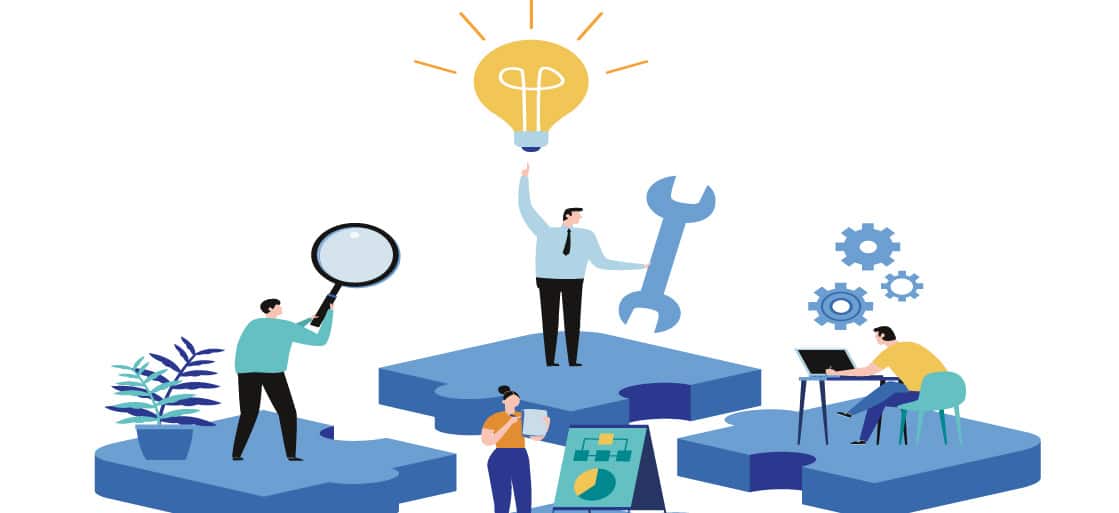Project collaboration is one of the most important parts of a large project. In this post, we will review 5 of the key concepts to keep in mind when forming a project team and planning out a major project. Without project collaboration, the pace of work will be much slower and workers will be less willing to share resources and insights. All five of these contribute to building a collaborate workplace.
Goals
The first thing you must do is create a set of concrete goals for the project. Goals promote collaboration because they provide focus, guidance, and information about what the teams need to do at specific times. They address both the psychological side of motivating workers to join their strengths together as well as the logistical benefits of organizing collaborative work and resources.
Before getting into that, it makes sense to discuss the importance of being concrete in setting goals. It is easy to come up with vague goals like “improve customer engagement” or “develop a more efficient production process.” It is important to boil those broad goals down into specific, actionable outcomes, like “improve site visits by 20 percent within six months” or “cut production costs by 10 percent without decreasing quality.” The difference is that the second examples are testable. You can tell if you have met the goal yet or not. A vague goal is impossible to use for guidance because you can’t tell what you need to do to make progress and there’s no way to assess for success.
Let’s start with the first point we mentioned earlier. Collaboration does not come naturally for everyone. Some workers are worried that others will take the credit for their work. Others feel they are more productive on their own. It can be difficult to show them that they will do more if they collaborate and the end result will be an improvement over a solo effort. One of the best ways to do that is by setting specific goals. That way, everyone can see what their responsibility is and what their team will accomplish. They won’t have to worry about others taking their credit because everyone will see everyone else’s assignment. Project collaboration means that everyone is working together toward the same goal. Well, without a reasonable goal you can’t do that.
Next, the logistics. Goals are important because they define what you need to do and when it needs to be done. Even if you only have one goal, you can use that goal to work backward and see what you have to do in order to reach the goal by the deadline. That way, one solid goal can become an entire timeline of responsibilities and tasks for the project. It is far from easy to settle on such a timeline without the structure of a goal, because a collaborative project depends on sharing resources, getting steps done in the right order, and coordinating on long-term timing. Use the project goal as the keystone in that process. Collaboration without guidance is just going to waste everyone’s time.
Project Collaboration Tools
An effective project management tool that allows team members, stakeholders and managers to collaborate with a direct tie to the project itself. Tools like Skype, email, etc have no tie to the project and collaboration can be lost.
The bottom line is that collaboration is related to communication, but it is much more. Effective collaboration will require the ability to share files and documents. That demands a cohesive platform that is ideally tied into the structure of the project itself, which would make it easier to exchange important files. If that is not possible, then the next best alternative is to find a solution that is capable of supporting the kind of interactions your project needs. This is a good opportunity to ask the workers what they would like to see in a collaborative platform. It might not be clear from any one individual’s perspective what the complete needs of the project are, but some form of open forum can help identify key elements.
A major part of the reason to not rely solely on email is the nature of email discussions themselves. Most workplaces already have a problem with overuse of email. It’s a common complaint that workers get too many emails that they don’t need to see, leading to discouragement and a lack of engagement with all email. That means many workers will already have a bias against the medium. Moreover, however, emails themselves are just not very useful. They have a tendency to work decently well for one-on-one conversations, but for group communication, they dissolve into confusion. Some people use “reply to all” and others just use “reply”, which leads to several different threads of conversation playing out between different people. The display of an email also makes it hard to follow long conversations between several people.
Better solutions include things like Leankor that are more conducive to conversations between several people with file-sharing. Look into ideas like a discussion board or forum with different sub-boards for topics, work groups, and so on. That can help solve the problem of confusing conversations. IT will play a key role in determining what solutions you have available and helping you implement and support them. There is no one solution that will fit every project because the needs of each project and its workers varies. In addition, it might be necessary to change the platform you use over time. For example, a successful project might grow over time and require more capacity.
Be attentive and adaptive to the evolving needs of your workers. They cannot collaborate effectively if they do not have a platform for doing so. It is tempting to rely on standard choices like email, but for the reasons above that tends to be insufficient. Be mindful of the nature of the workforce. The needs of a project that is entirely contained in one office floor are very different from the needs of a project with work groups in subsidiaries all across the world in different time zones. There is a lot that goes into choosing the right collaboration platform and it can have a big effect on the project, so make sure you give it careful consideration.
Input
Project collaboration needs to be a multi-way component, with all team members, stakeholders, etc being able to collaborate at the same level and same authority. Without this people can feel that they are not allowed to add ideas, bring up negative aspects, be creative, etc.
This is not to say that there is no hierarchy without a project. There are people who have to spend their time deciding on how everyone else should spend their own time. However, do not think of that as a position of power. Think of it as just another part of getting the project done. The managers and coordinators are trying to facilitate collaboration and meet goals. That does not make them more important or give their voice more weight if someone else on the team comes up with a good idea. Each member of the team should feel welcome to provide input. Not all of it will be useful, but it’s important to build a culture where everyone is willing to speak up. That means no good ideas will ever go unspoken.
Collaboration is about good communication and a sense of belonging to a team. If people don’t think they can talk about the project and make suggestions, then that means they won’t buy into the objectives. That, in turn, destroys the team attitude that links everyone together. It comes down to the fact that even if none of the input that anyone offers winds up making a difference, the very fact that they could express it showed that they were invested and interested in going above and beyond. They were inspired to do more. Good project collaboration can push people to do more than they normally would. For some, it’s about trying to solve an interesting problem as a group, while for others it might be to build a case for a promotion by showing initiative in front of an audience. Whatever the motivation is, the presence of feedback means that they care and they want to contribute.
Project collaboration is based on meeting goals as a team, but there is an element of spontaneity as well. A good suggestion could start off a whole new branch of the project or revamp part of the existing workflow. Part of building a good culture is not just encouraging feedback, but actually listening and implementing that feedback when appropriate. If you allow people to speak but never listen, it will become clear quickly and you will lose the trust of the team. Act on their suggestions and you will inspire more people to weigh in. Any one of those ideas could wind up saving a lot of money or getting the timeline accelerated. It fosters a sense of camaraderie among the workers and removes some of the social barriers that can impede project collaboration. In short, you have to do a little more than set up a suggestion box, but the payout can be well worth the effort.
Trust
Building on that last point, a key element in a strong collaborative team is trust. Each work group trusts the others and each worker trusts their coworkers. This is not quite the same meaning of trust as the social interpretation we use most of the time, which tends to involve a willingness to share personal information. Workplace trust means dependability, that each person trusts the others to be competent and to do a good job. Not only does that trust help ensure buy-in and promote closer relationships, it also leads to a direct reduction in redundant work. If one work group has to work with another, but does not trust them to do a good job, they will often spend time checking and re-checking everything that the other group does. That is time, that they could spend on getting things done. It also hurts the relationship between those two groups. They are less likely to share resources or do extra work to help each other if there is mistrust between them.
A lack of trust is a serious problem in collaboration. Having a successful team depends on making sure each person knows their place in the project and how they relate to everyone else. They have to be able to trust that the people around them are working just as hard, are just as competent, and will make good decisions for the future of the project. A breakdown in any one of those things could lead to disengagement.
Trust is also essential to building identity. Workers need to identify as contributors to their project. If they feel alienated or unappreciated due to a lack of trust, they won’t be as interested in being close to the project. That leads to many negative outcomes. They will put in less work, they won’t feel motivated to go the extra mile if they have a new idea, they will lose interest in making sure their work is good, and so on. Dangerously, this can spread. The appearance of one person who has checked out will lead others not to trust that person, and it can spiral out of control if the workers lose their common bond and begin to accuse each other of apathy or a lack of work ethic.
It behooves to you cultivate and maintain a culture of mutual trust and respect from the very beginning. This can sometimes be a challenge. Sometimes it is easy to get everyone to feel trusting early on, but it falls apart quickly when, for example, a team falls behind schedule on an important step. These are the moments when you need to step in and bring the project team back together again. It’s a test of how well you can repair relationships and reestablish positive norms. Once a project falls into negativity, the potential for failure increases. It isn’t easy to win back trust, and that is why getting off to a good start is so important. It’s important enough that you need to craft a strategy for how to maintain trust for the duration of the project.
People
One of the most challenging aspects of creating a collaborative project team is finding the right people. The difficulty is in finding a balance between individual talent and ability to work with others. When you are choosing who you want to participate, you often do not get to select individuals because you have to recruit whole teams at once. This is an additional layer of complexity. However, project collaboration depends on people who are willing and able to be productive working with others. Individuals who work alone will find it hard to contribute in a group setting and other group members may become resentful.
There are a few different approaches to finding the best team-oriented people. First, you could start from skillsets. You already understand what kind of people you will need in terms of their abilities and experience, so it makes sense, to begin with, a list of roles in the project. Then come up with a list of a few potential candidates for each role, if possible. In some cases, you will only have one candidate. It may turn out that there are none in the company, which might necessitate an external hire. In any case, you will have to talk to each of the candidates and try to settle on which are most suited to project collaboration. If any of them have worked together before, that is a bonus.
You should also consider personality. Starting from skills makes the most sense if you need a lot of different roles. But if for example, the project involves the work of several people with similar skillsets, then you may find it better to interview for personality types that mesh. You can also apply this technique if you have a large pool of candidates after screening for skills. You can look for people who are outgoing, but not overbearing, and who are happy to work with others.
Whichever method you choose, the idea is the same. You need people who can do the work and who are comfortable with project collaboration. It might seem obvious, but many managers neglect to ask their prospects about their previous experience working in groups. Ideally, you would know all the candidates well enough ahead of time to not need to ask, but that does not always happen. Sometimes you do not have much choice- there is a limited pool of candidates in the company because you need certain skills. In those cases, you need to do your best to ensure that you can facilitate collaboration by building good relationships.






